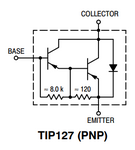venkates2218
Full Member level 6
Please refer the image,TIP127 is interfaced with PIC18F4520 to control an LED.The objective is LED have to blink,but LED connected at output of TIP127 is always in ON condition.
While checking MCU pin with another LED,it blinking as like program.Input to TIP127 is +12VDC.
How to solve this issue with TIP127.?
While checking MCU pin with another LED,it blinking as like program.Input to TIP127 is +12VDC.
How to solve this issue with TIP127.?
